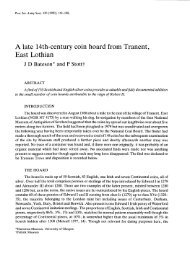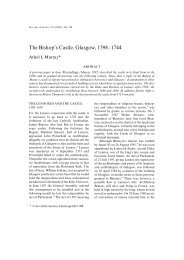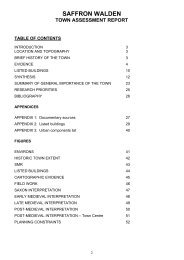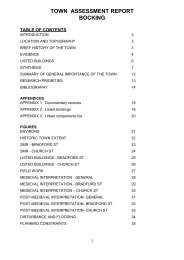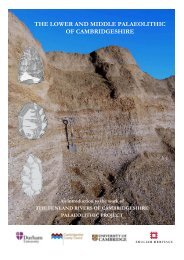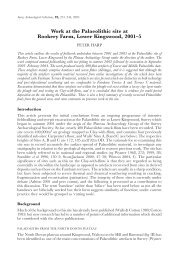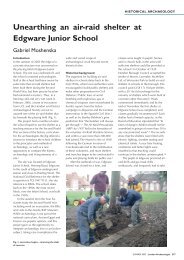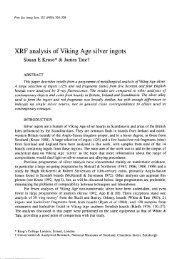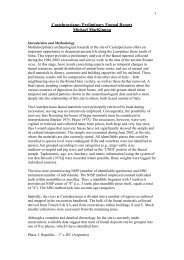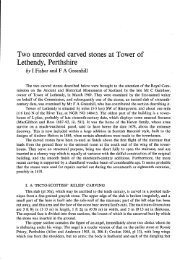The late Iron Age and Roman settlement at Leda Cottages, Westwell ...
The late Iron Age and Roman settlement at Leda Cottages, Westwell ...
The late Iron Age and Roman settlement at Leda Cottages, Westwell ...
Create successful ePaper yourself
Turn your PDF publications into a flip-book with our unique Google optimized e-Paper software.
CTRL Integr<strong>at</strong>ed Site Report Series <strong>Leda</strong> <strong>Cottages</strong>, <strong>Westwell</strong><br />
8627 formed the south-western half of its south-eastern boundary <strong>and</strong> 8638 was a small<br />
surviving L-shaped segment situ<strong>at</strong>ed <strong>at</strong> the east corner (section 947, Fig. 7). Ditch 8627 ran<br />
for <strong>at</strong> least 49 m, had a V-shaped profile <strong>and</strong> a slightly concave base, <strong>and</strong> was between 0.5<br />
<strong>and</strong> 1 m wide <strong>and</strong> 0.1 to 0.45 m deep. Corner ditch 8638 was aligned NW-SE then NE-SW<br />
with a visible extent of 5 m, a V-shape profile with a concave bottom <strong>and</strong> a depth of 0.20 m.<br />
Ditch 8627 produced an assemblage of 17 sherds (118 g) of mostly undiagnostic pottery,<br />
except for one sherd d<strong>at</strong>ed to AD 1-50 <strong>and</strong> another d<strong>at</strong>ed to AD 110-270. Ditch 8638<br />
contained only two very small sherds (3 g) but one of them was in <strong>Roman</strong> fine grey ware, <strong>and</strong><br />
is thus of post-Conquest d<strong>at</strong>e.<br />
<strong>The</strong> northern enclosure as it appears on Figure 7 is perfectly aligned on the southern<br />
enclosure, which implies th<strong>at</strong> the former was dug to mirror the l<strong>at</strong>ter. <strong>The</strong> gap between the<br />
two could have been used as a trackway. As discussed above, the d<strong>at</strong>ing evidence from<br />
ditches 8627 <strong>and</strong> 8638 is very tenuous <strong>and</strong> indic<strong>at</strong>es considerable residuality. However most<br />
d<strong>at</strong>ing evidence recovered from the northern enclosure came from the <strong>l<strong>at</strong>e</strong>r ditches which<br />
produced a mixed assemblage of middle <strong>Roman</strong> pottery <strong>and</strong> residual <strong>l<strong>at</strong>e</strong> <strong>Iron</strong> <strong>Age</strong>/early<br />
<strong>Roman</strong> sherds in fresh condition. <strong>The</strong> residual pottery was recovered from the re-cut (8640)<br />
of ditch 8627 <strong>and</strong> was likely to have originally been part of the fills of 8627. <strong>The</strong> most likely<br />
explan<strong>at</strong>ion is th<strong>at</strong> the original extent of the northern enclosure was very similar to the extent<br />
of the middle <strong>Roman</strong> enclosure as visible on Figure 7. Ditch 8638 in particular is likely to<br />
have extended as far as its re-cut, but was almost entirely obliter<strong>at</strong>ed by this except in the<br />
south-east corner.<br />
<strong>The</strong> slight d<strong>at</strong>ing evidence suggests th<strong>at</strong> the northern enclosure ditch was excav<strong>at</strong>ed<br />
shortly after the Conquest, probably not much after c AD 50. <strong>The</strong> alignment of the two<br />
enclosures suggests th<strong>at</strong> they were both in use when the second one was established. However<br />
its seems th<strong>at</strong> the southern enclosure boundaries were mostly filled up by AD 70. <strong>The</strong><br />
southern enclosure probably survived for some time after th<strong>at</strong>, perhaps defined by positive<br />
fe<strong>at</strong>ures such as banks or hedgerows lying alongside the silted up ditches.<br />
Internal fe<strong>at</strong>ures<br />
A number of discrete fe<strong>at</strong>ures were d<strong>at</strong>ed to the early <strong>Roman</strong> phase. Only one large pit within<br />
the southern enclosure (8321) was d<strong>at</strong>ed to this period. It measured 1.70 by 1.50 m, <strong>and</strong> was<br />
0.38 m deep. It produced 46 sherds of pottery (880 g) ranging from AD 70 to AD 190. Other<br />
artefacts included 407 g of slag <strong>and</strong> a fragment of the upper stone of a rotary quern. It was<br />
possibly a rubbish pit.<br />
Two fe<strong>at</strong>ures were identified. just outside the western entrance to the southern<br />
enclosure, Sub-circular pit 8573 measured 2.85 m NE-SW <strong>and</strong> 2.75 m NW-SE, with a depth<br />
of 0.78 m. This very large fe<strong>at</strong>ure was in use for a long period of time <strong>and</strong> may have been a<br />
11






